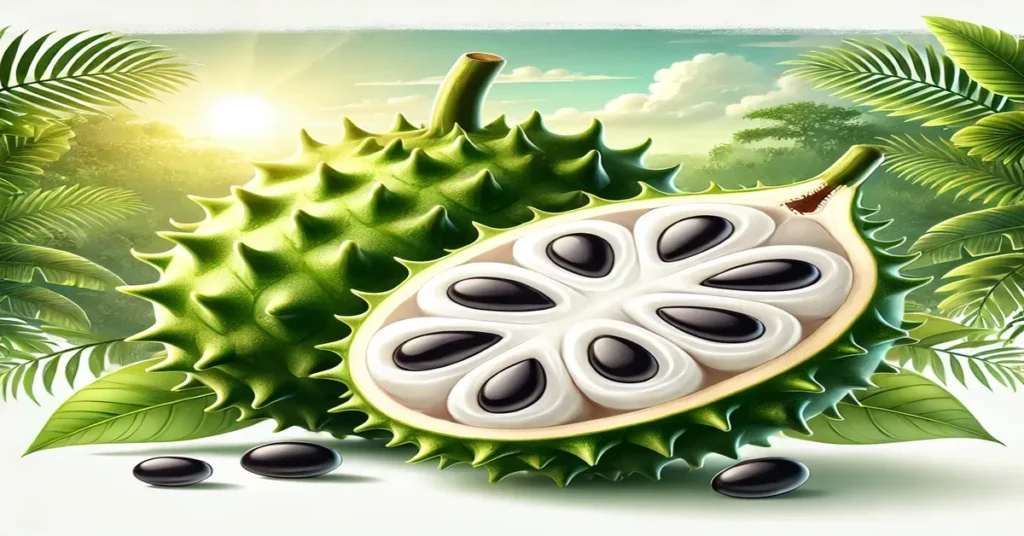Guanabana, also known as soursop or graviola, is a tropical fruit that has gained global attention due to its unique flavor and impressive health benefits. Native to the tropical regions of the Americas, guanabana is now grown in various parts of the world where the climate is warm and humid. This spiky green fruit is not only a culinary delight but also a nutritional powerhouse, with potential medicinal properties that have made it a subject of interest in scientific research.
In this comprehensive article, we will delve into everything you need to know about guanabana, including its origins, nutritional composition, health benefits, culinary uses, and potential risks. We will also address common questions about this fascinating fruit to provide a well-rounded understanding of its significance.
Origins and History of Guanabana
Guanabana (Annona muricata) belongs to the Annonaceae family, which includes several other tropical fruits like cherimoya and custard apple. The plant is native to the Caribbean, Central America, and parts of South America. Indigenous peoples have used guanabana for centuries, both as a food source and for its purported medicinal properties.
The fruit’s popularity has since spread to Asia, Africa, and the Pacific Islands, where it is cultivated for its delicious pulp and therapeutic applications. Its unique combination of sweet and tangy flavors makes it a prized ingredient in desserts, beverages, and traditional dishes.
Nutritional Composition of Guanabana
Guanabana is packed with essential nutrients that contribute to its status as a superfruit. A 100-gram serving of raw guanabana pulp provides the following:
- Calories: 66 kcal
- Carbohydrates: 16.8 g
- Protein: 1 g
- Fat: 0.3 g
- Fiber: 3.3 g
- Vitamin C: 20.6 mg (34% of the daily recommended intake)
- Potassium: 278 mg
- Magnesium: 21 mg
- Calcium: 14 mg
- Iron: 0.6 mg
Guanabana is also rich in antioxidants, such as acetogenins, quercetin, and luteolin, which contribute to its health-promoting properties.
Health Benefits of Guanabana
1. Rich in Antioxidants
Guanabana contains a variety of antioxidants that help neutralize free radicals in the body, reducing oxidative stress and preventing cellular damage. These antioxidants play a crucial role in lowering the risk of chronic diseases, including heart disease and cancer.
2. Boosts Immunity
The high vitamin C content in guanabana strengthens the immune system by stimulating the production of white blood cells. It also helps in wound healing and protects the body against infections.
3. Supports Digestive Health
The dietary fiber in guanabana aids digestion by promoting regular bowel movements and preventing constipation. It also supports the growth of beneficial gut bacteria, contributing to overall gut health.
4. May Have Anti-Cancer Properties
Studies have suggested that the acetogenins in guanabana may have anti-cancer effects by inhibiting the growth of cancer cells. Research is ongoing, but preliminary findings indicate potential benefits in treating certain types of cancer, including breast, liver, and prostate cancer.
5. Regulates Blood Pressure
Guanabana is a good source of potassium, which helps regulate blood pressure by counteracting the effects of sodium. Its natural vasodilatory properties further contribute to improved cardiovascular health.
6. Promotes Healthy Skin
The antioxidants and vitamin C in guanabana help maintain healthy skin by reducing inflammation and protecting against damage caused by UV rays and pollution. Regular consumption of guanabana may result in a clearer and more youthful complexion.
7. Relieves Inflammation
The anti-inflammatory properties of guanabana make it beneficial for individuals suffering from conditions such as arthritis and gout. It can help reduce pain and swelling, improving overall quality of life.
Culinary Uses of Guanabana
Guanabana’s creamy texture and unique flavor profile make it a versatile ingredient in the kitchen. Here are some popular ways to enjoy this tropical fruit:
1. Juices and Smoothies
Guanabana pulp can be blended with water, milk, or other fruits to create refreshing juices and smoothies. It pairs well with tropical fruits like mango, pineapple, and coconut.
2. Desserts
The sweet and tangy flavor of guanabana makes it an excellent choice for desserts. It can be used to make ice creams, sorbets, puddings, and cakes.
3. Traditional Dishes
In many cultures, guanabanas is used in traditional recipes. For instance, in the Caribbean, it is often included in custards and sweet pastries.
4. Snacks
Dried guanabana pulp is a convenient snack option, while fresh guanabanas can be eaten on its own by scooping out the pulp with a spoon.
Potential Risks and Precautions
While guanabana offers numerous health benefits, it is essential to be aware of potential risks and precautions:
- Neurotoxicity: Some studies suggest that excessive consumption of guanabana may have neurotoxic effects due to certain compounds in the seeds and leaves. It is advisable to consume the fruit in moderation and avoid the seeds.
- Allergic Reactions: People with allergies to tropical fruits may experience reactions to guanabana. Symptoms may include itching, swelling, or difficulty breathing.
- Interaction with Medications: Guanabana may interact with medications, particularly those used to treat hypertension or diabetes. Consult a healthcare professional before incorporating it into your diet if you are on medication.
- Pregnancy and Breastfeeding: Pregnant and breastfeeding women should consult their doctors before consuming guanabanas, as its safety during these stages has not been conclusively established.
Growing and Harvesting Guanabana
Guanabanas trees thrive in tropical climates with high humidity and temperatures between 25°C and 30°C (77°F to 86°F). They require well-drained soil and regular watering to produce high-quality fruits. The trees typically bear fruit within three to five years of planting and can yield up to 12 fruits per season.
The fruits are harvested when they are fully grown but still firm. They continue to ripen off the tree, becoming softer and more flavorful.
Sustainability and Economic Importance
Guanabana cultivation provides livelihood opportunities for farmers in tropical regions. Its growing popularity in international markets has boosted demand, making it an economically significant crop. However, sustainable farming practices are crucial to prevent deforestation and ensure the long-term viability of guanabanas production.
Conclusion
Guanabanas is more than just a delicious tropical fruit; it is a nutritional treasure trove with potential health benefits that make it a valuable addition to any diet. From boosting immunity to supporting digestive health and possibly even combating cancer, this versatile fruit has much to offer. However, moderation and awareness of potential risks are key to enjoying guanabanas safely.
Whether you savor it as a juice, dessert, or snack, guanabanas promises a delightful experience for your taste buds and a boost to your overall well-being.
FAQs About Guanabana
1. What does guanabana taste like?
Guanabanas has a unique flavor that is often described as a combination of strawberry, pineapple, and citrus, with a creamy texture reminiscent of banana or coconut.
2. Is guanabana good for weight loss?
Yes, guanabanas can support weight loss due to its low calorie and high fiber content, which promotes satiety and aids digestion.
3. Can guanabana cure cancer?
While guanabanas contains compounds with potential anti-cancer properties, it is not a proven cure for cancer. Consult a medical professional for appropriate treatment.
4. How do you store guanabana?
Fresh guanabanas should be stored at room temperature until it ripens. Once ripe, it can be refrigerated for up to three days or frozen for longer storage.
5. Are guanabana seeds edible?
No, guanabanas seeds are not edible and may be toxic if ingested. Always remove the seeds before consuming the fruit.
6. Can guanabana be grown indoors?
Guanabanas trees require ample sunlight and space, making them challenging to grow indoors. However, in climates with suitable conditions, they can be cultivated in large pots or greenhouses.







